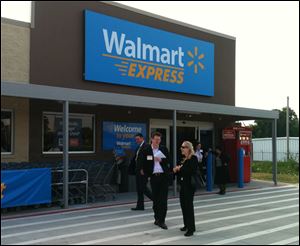
Wal-Mart rushing to return to 1-stop roots
6/12/2011
Walmart Express stores such as this one in Gentry, Ark., are the heart of the strategy.
NEW YORK -- Wal-Mart Stores Inc. is in a race against time to give the people what they want before they get comfortable shopping elsewhere.
Shoppers who switched to other stores when the company decided to ditch best-selling toothbrush brands, craft supplies, and bolts of fabric may be hard to win back.
Wal-Mart has taken nine months to restore thousands of grocery items -- including some best-selling brands -- it dumped two years ago. The idea was to tidy up stores for the wealthier customers it had won during the recession.
Grocery sales have improved, rising in the low single digits in the first quarter. But overall traffic at its U.S. namesake stores has been down, and revenue at stores open at least a year has posted eight straight year-over-year quarterly declines.
Wal-Mart said restocking the rest of the items that were culled -- from craft supplies to home furnishings -- will take until the end of the year. Accomplishing that mission will go a long way toward restoring one-stop shopping, which could be a plus as shoppers make fewer trips to save on gasoline.
"The customer, for the most part, is still in the store shopping, but they started doing some more shopping elsewhere, and we want to bring them back. We know that it's easy to lose them," Charles Holley, Wal-Mart's chief financial officer, said during a recent consumer conference.
Dollar stores, which benefited from shoppers trying to stretch their dollars in the recession, are continuing to gain customers and post higher revenue. Such stores more adroitly maneuvered the post-recession economy. They have expanded their inventory, particularly brand names, become more competitive on price, and are expanding to new locations.
Meanwhile, some wealthier shoppers are trading back up to the mall or higher-end grocery stores such as Whole Foods.
Wal-Mart is increasingly "caught in the middle" between dollar stores and more expensive stores, Brian Sozzi, an analyst at Wall Street Strategies, said. "Now, it's trying to return to its roots, but it's facing old competitors -- the dollar stores -- that are getting much better."
Richard Hastings, a consumer strategist with Global Hunter Securities, gives Wal-Mart two years to woo back its U.S. customers before their new shopping habits are imprinted.
But the restocking has taken longer than Wal-Mart predicted. In November, it had said the merchandise it cut would be restored by spring.
Even when Wal-Mart has been able to get goods to the stores, the company known for its efficiency and precision has had trouble getting them onto shelves, said Cameron Smith, who recruits executives for Wal-Mart suppliers and also is an adviser to the retailing giant.
Suppliers are using third parties to backstop the placement of their goods on the shelves, he said. That adds to their costs.
And, Mr. Sozzi noted, pallets of merchandise are crowding aisles.
Wal-Mart's international business has propped up revenue and profits. The namesake Walmart stores account for 62 percent of the company's revenue; international makes up 26 percent.
Although not committing to a specific time frame for turning around its domestic revenue, Wal-Mart has said it expects results to continue to improve as the year goes on.
Mike Duke, the chief executive officer, is expected to once again emphasize how the company is re-creating a destination, where customers can pick up a wide assortment under one roof. The company is putting guns, fishing poles, crafts, and fabric back in its stores. In Texas, it is experimenting with washers and dryers to go up against Home Depot and Sears.
To address the increasing threat of dollar stores, Wal-Mart will open the first of up to 20 Walmart Express stores planned for this year. These stores are a tenth the size of a supercenter, or about the size of a typical drugstore. The first such store, in Gentry, Ark., is to open this month.
Walmart Express is aimed at taking out one of the dollar stores' advantages: proximity to residential areas.
High gas prices have made that even more important. The cost of gas to get to the store now represents 11.4 percent of the cost of a dollar store transaction, compared with 15.1 percent of a Wal-Mart transaction, according to an analysis by Credit Suisse of average purchases at Walmart and dollar stores. The average round trip to a dollar store is six miles, compared with 30 for a typical Wal-Mart trip, Credit Suisse analyst Michael Exstein estimated.